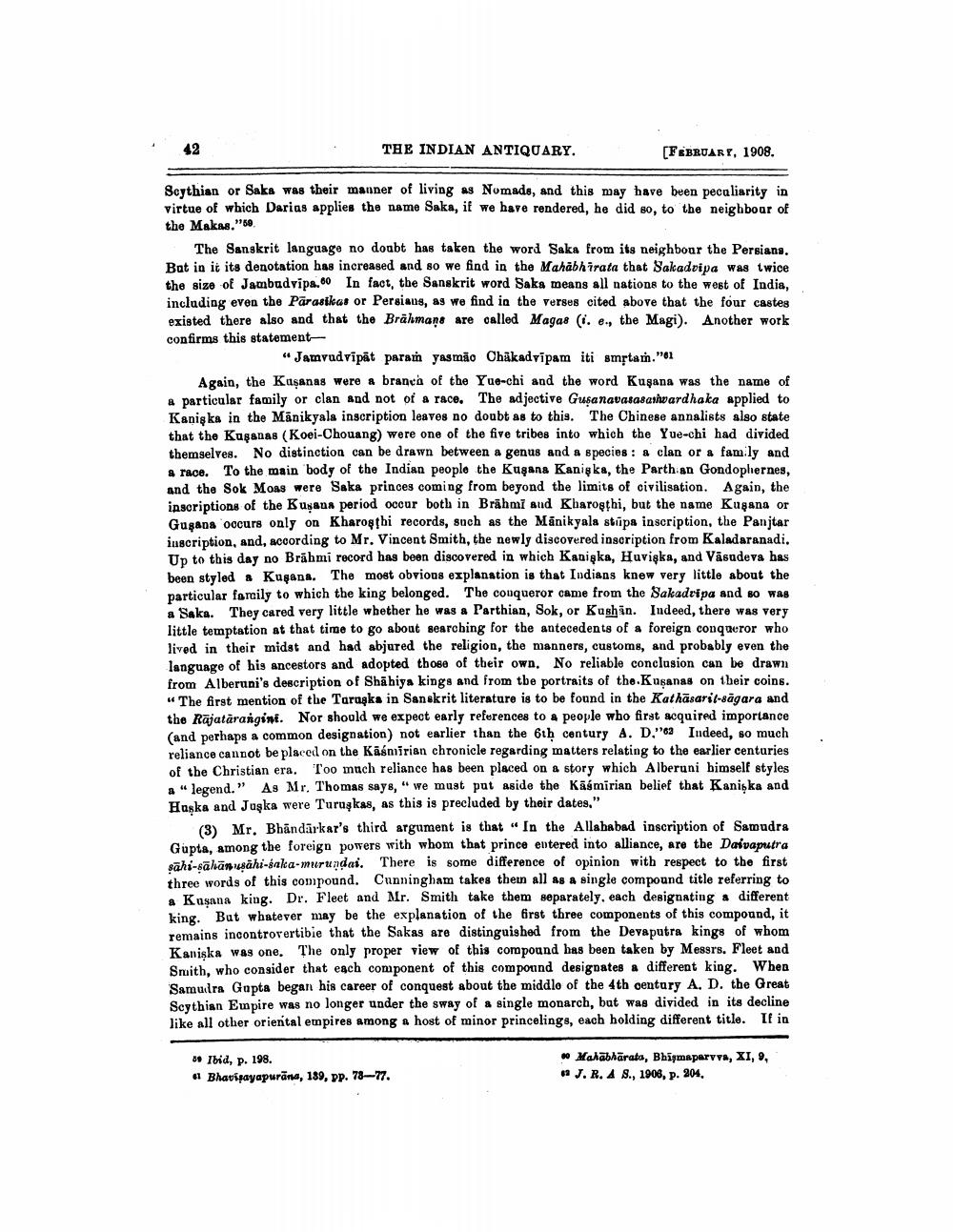________________
42
THE INDIAN ANTIQUARY.
[FEBRUARY, 1908.
Scythian or Saka was their manner of living as Nomads, and this may have been peculiarity in virtue of which Darias applies the name Saka, if we have rendered, he did so, to the neighbour of the Makas."50.
The Sanskrit language no doubt has taken the word Saka from its neighbour the Persians. But in it its denotation has increased and so we find in the Mahabhirata that Sakadvipa was twice the size of Jambudvipa.60 In fact, the Sanskrit word Saka means all nations to the west of India, including even the Parasikas or Persians, as we find in the verses cited above that the four castes existed there also and that the Brahmans are called Magas (i. e., the Magi). Another work confirms this statement
"Jamvudvipat param yasmão Chakadvīpam iti smṛtam."61
Again, the Kusanas were a branch of the Yue-chi and the word Kusana was the name of a particular family or clan and not of a race. The adjective Gusanavasasamhvardhaka applied to Kaniska in the Manikyala inscription leaves no doubt as to this. The Chinese annalists also state that the Kusanas (Koei-Chouang) were one of the five tribes into which the Yue-chi had divided themselves. No distinction can be drawn between a genus and a species: a clan or a family and a race. To the main body of the Indian people the Kugana Kaniska, the Parth an Gondophernes, and the Sok Moas were Saka princes coming from beyond the limits of civilisation. Again, the inscriptions of the Kusana period occur both in Brahmi and Kharosthi, but the name Kugana or Gugana occurs only on Kharosthi records, such as the Manikyala stupa inscription, the Panjtar inscription, and, according to Mr. Vincent Smith, the newly discovered inscription from Kaladaranadi. Up to this day no Brahmi record has been discovered in which Kaniska, Huviska, and Vasudeva has been styled a Kugana. The most obvions explanation is that Indians knew very little about the particular family to which the king belonged. The conqueror came from the Sakadripa and so was a Saka. They cared very little whether he was a Parthian, Sok, or Kushin. Indeed, there was very little temptation at that time to go about searching for the antecedents of a foreign conqueror who lived in their midst and had abjured the religion, the manners, customs, and probably even the language of his ancestors and adopted those of their own. No reliable conclusion can be drawn from Alberuni's description of Shahiya kings and from the portraits of the Kusanas on their coins. "The first mention of the Taraska in Sanskrit literature is to be found in the Kathasarit-sagara and the Rajatarangini. Nor should we expect early references to a people who first acquired importance (and perhaps a common designation) not earlier than the 6th century A. D."62 Indeed, so much reliance cannot be placed on the Kasmirian chronicle regarding matters relating to the earlier centuries of the Christian era. Too much reliance has been placed on a story which Alberuni himself styles a "legend." As Mr. Thomas says, "we must put aside the Kaśmirian belief that Kaniska and Huska and Juska were Turuskas, as this is precluded by their dates,"
แ
(3) Mr. Bhandarkar's third argument is that "In the Allahabad inscription of Samudra Gupta, among the foreign powers with whom that prince entered into alliance, are the Daivaputra sahi-sähänsähi-saka-murundai. There is some difference of opinion with respect to the first three words of this compound. Cunningham takes them all as a single compound title referring to a Kusana king. Dr. Fleet and Mr. Smith take them separately, each designating a different king. But whatever may be the explanation of the first three components of this compound, it remains incontrovertibie that the Sakas are distinguished from the Devaputra kings of whom Kaniska was one. The only proper view of this compound has been taken by Messrs. Fleet and Smith, who consider that each component of this compound designates a different king. When Samudra Gupta began his career of conquest about the middle of the 4th century A. D. the Great Scythian Empire was no longer under the sway of a single monarch, but was divided in its decline like all other oriental empires among a host of minor princelings, each holding different title. If in
59 Ibid, p. 198.
41 Bhavijayapurāna, 139, pp. 78-77.
0 Mahabharata, Bhismaparvva, XI, 9,
62 J. R. A S., 1906, p. 204,




